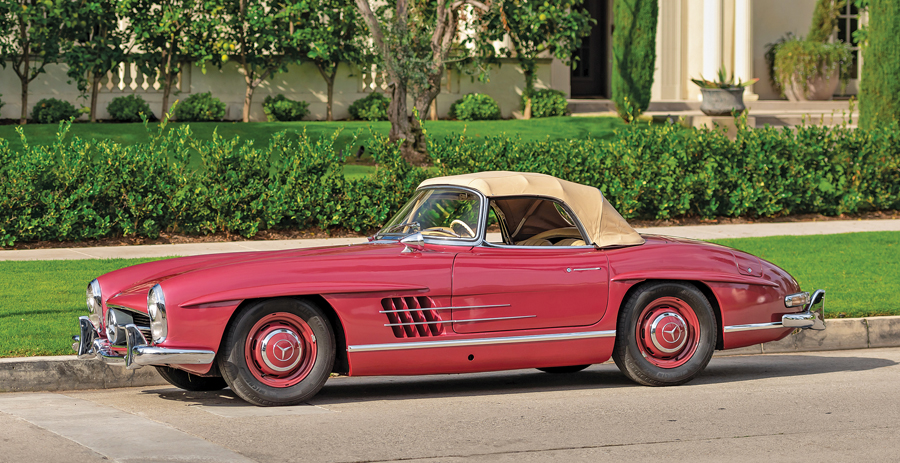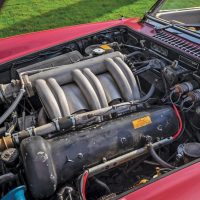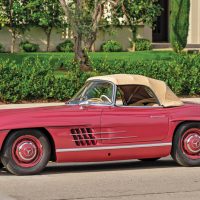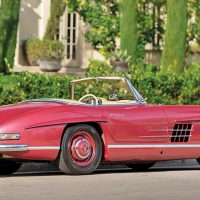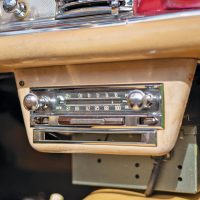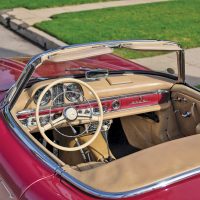SCM Analysis
Detailing
| Vehicle: | 1957 Mercedes-Benz 300SL Roadster |
| Years Produced: | 1957–63 |
| Number Produced: | 1,377 (drum brake, 1957–61), 269 (disc brake, 1961–62), 210 (disc brake, alloy engine, 1962–63). 1,856 total |
| Original List Price: | $13,000 |
| SCM Valuation: | $1,072,500 |
| Tune Up Cost: | $5,000 |
| Chassis Number Location: | Tag on firewall and stamped into front crossmember |
| Engine Number Location: | Riveted tag and stamped number on front right side of block below head |
| Club Info: | 300SL Gullwing Group |
| Website: | http://www.gullwinggroup.com |
| Alternatives: | 1958–63 Aston Martin DB4, 1956–59 BMW 507, 1962–64 Ferrari 250 GT/L Lusso |
| Investment Grade: | A |
This car, Lot 256, sold for $973,000, including buyer’s premium, at RM Sotheby’s sale in Scottsdale, AZ, on January 17, 2020.
A dramatic and original Mercedes-Benz, this Strawberry Red (DB 573 poly) 300SL should have been a record breaker, but it fell short of perceived market expectations. Regardless, it still sold above its low estimate of $950,000.
Our subject car has a number of precious attributes, including an original leather interior and a consistent ownership chain with no stories. If you’re wondering whether our subject car is underpriced, the answer to that question is obvious. But low prices are not always important in this market segment.
300SL values are highly subjective
When a potential buyer is searching for a 300SL — or a similarly expensive car — there are often other variables to consider. At some point, every prospective buyer must ask the following questions: “How did I imagine my perfect 300SL? What do I want it to look like? What impressions do I wish to convey while driving it?”
Frequently, when the right W198 is offered, serious bidders already know what they want. They rarely ask themselves if they can afford the car or not — analyzing how much the purchase will hurt is not the same as judging whether you can make the purchase. If you’ve arrived at the point where you are seriously looking to buy a 300SL, you can probably afford any 300SL Roadster on the market. That kind of purchasing power entitles one to be discriminating.
The proliferation of blandness
In today’s classic-car culture, any uniquely colorful automobile is an endangered species.
Prospective owners are told that “they have the right to change the color of their classic to anything they wish.” After all, it is their car, isn’t it?
However, the market erupts over silver, black or graphite gray 300SLs. In fact, thanks to its ties to German racing history, DB180 Silver-Gray has been the “safe” color of every 300SL. Not that I am trying to disparage anyone who likes gray, but “grayness” has saturated everything. This is a hard place for a Strawberry Red Metallic 300SL to find an enthusiastic home.
A color too beautiful for everyone
I would happily own and enjoy a 300SL in Strawberry Metallic, but if I could purchase a 300SL in any color I wanted, I don’t know if this would be the one I would choose.
I have a feeling that many potential buyers feel this way. As blandness proliferates, a color like this will struggle more and more in the marketplace.
Even though one of them inherited it, two of the car’s previous owners were female. The original owner, Jim Gilmore, was the exception to every 300SL purchaser when he ordered this car in a color that a woman would likely favor — but a typical man would run from.
The color is not just a flamboyant choice. It does an excellent job of accentuating the silhouette of the W198 in a way most other colors fail to do. Indeed, this color brings out the beauty in the beast. It is a subtle red dress shrouding an attractive figure. It’s a statement not so much about the owner, but about the car itself.
This color presents a number of quandaries. First of all, this car was likely painted three times in its life (early synthetic enamels had short lives), so it is fair to assume it had been painted once when Gilmore owned it, probably when it was between 10 and 15 years old. However, many 300SLs have been painted more than three times, and many cars have often been painted non-original colors and then changed back again.
Because it is such an original car in such a striking color, buyers who wanted a 300SL but refrained from bidding likely understood that disrupting this car’s originality would be a crime. Hopefully, no color changes will ruin the Gilmore car.
Basic conditions for buying a 300SL
The typical 300SL purchaser usually goes through the following thought processes when they seek out the right car:
Is this car the right color? Red Mercedes are usually less favored and can be purchased at a discount. Serious long-term buyers often reject red Mercedes.
Next, has the car had a color change? Regardless of what the guilty parties say, changing the color of a 300SL — even if it was decades ago — still hurts the value of the car. This is not as bad if the colors were changed from something like white to silver, but it gets a lot more tricky when a desirable color is exchanged for anything else (for example, black to red or silver to aquamarine).
Originality and value
The car’s originality is very, very important. That inquiry has a different meaning in the 300SL world — and actually consists of several questions. First of all, do all the numbers match? To complicate things, there are two sets of numbers on a 300SL.
The first set involves the mechanical components. The engine, transmission, rear axle, steering box and front suspension assemblies are all numbered, and those numbers are all stamped on the data card. On a true original car, these numbers will match the ones on the data card.
The body panels are all stamped with a three-digit assembly number, and these should all match as well, although they are not referenced on the data card. However, many of these numbers were obscured during generations of bodywork, so they should not be used as a primary determinant.
While no reference was made of these numbers on our subject car, most auction companies shy away from discussing them. A discussion of these numbers frequently creates more questions than answers, so they are often ignored.
The best 300SLs may not meet all of the matching-numbers criteria, as engines, gearboxes and rear axles were frequently damaged and replaced with new factory or rebuilt units.
The usual questions about disc brakes and alloy blocks also come into play, but these are discussed to the point of boredom. These things are good to have, but they won’t make an unoriginal or mistreated car great.
A missed opportunity
This 300SL, based on the information given, is a superb original car.
The sale price was an opportunity, but was also reflective of visual preferences for high-dollar collectible cars. While this 300SL was well bought, the price is probably the summit for a 1957 Strawberry Red Metallic Roadster.
Unique cars like this sometimes have limited market appeal, but that does not diminish the overall quality and beauty of this car.
This was a missed opportunity for anyone seeking an excellent W198. My hat goes off to the new owner for daring to be different, and for appreciating the virtues of this 300SL — regardless of market fickleness. ♦
